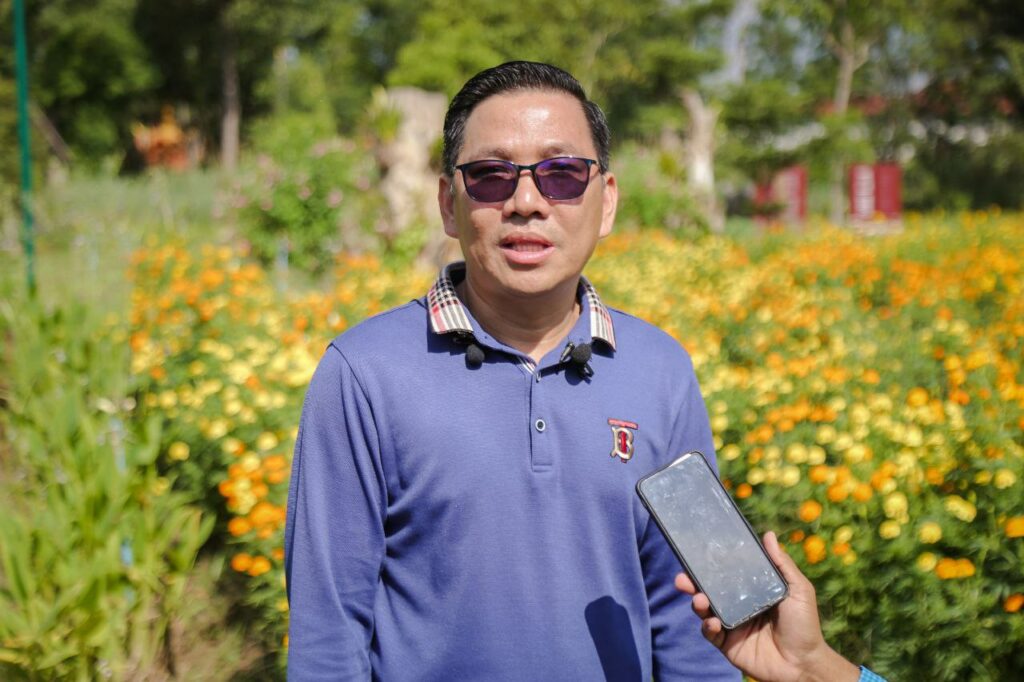Share Post:

សួនរុក្ខជាតិអង្គរស្ថិតនៅតាមបណ្តោយរុក្ខវិថីព្រះសីហនុ ឆ្ពោះទៅប្រាសាទអង្គរវត្ត នៃរមណីយដ្ឋានអង្គរ។ សួននេះ ត្រូវបានរៀបចំកែលម្អដោយមានរុក្ខជាតិ និងផ្កាចម្រុះជាង៥០០ប្រភេទ និងរាប់ម៉ឺនដើម។
ឯកឧត្តម យិត ចាន់ដារដ្ឋ អគ្គនាយករងអាជ្ញាធរជាតិអប្សរា និងជាអ្នកទទួលបន្ទុករៀបចំសួននេះមានប្រសាសន៍ថា សួនរុក្ខជាតិអង្គរ មានឈ្មោះដើមជាសួនគ្រឿងទេស បង្កើតឡើងពីឆ្នាំ ២០០៥ ដែលកាលណោះមានផ្ទៃដីប្រមាណ២ហិកតាប៉ុណ្ណោះ។ ឯកឧត្តមបន្តថា ចាប់ពីឆ្នាំ ២០១៨ មក សួននេះត្រូវបានរៀបចំកែលម្អ និងពង្រីករហូតដល់ជាង ១៥ហិកតា ក្រោមការឧបត្ថម្ភ និងគំនិតផ្តួចផ្តើមរបស់ឯកឧត្តម ជា សុផារ៉ា ឧបនាយករដ្ឋមន្រ្តី រដ្ឋមន្រ្តីក្រសួងរៀបចំដែនដី នគររូបនីយកម្ម និងសំណង់ ក្នុងបំណងចង់ឃើញសួនមានភាពទាក់ទាញ និងសក្តានុពលខ្លាំងជាងមុន សម្រាប់ជាប្រយោជន៍ប្រជាជន និងទេសចរជាតិ-អន្តរជាតិ។
តាមការបញ្ជាក់ពីឯកឧត្តម យិត ចាន់ដារដ្ឋ សួនរុក្ខជាតិអង្គរនេះត្រូវបានរៀបចំជា៥សួនធំៗប្លែកពីគ្នា។ ទី១ សួនគ្រឿងទេស និងសួនឱសថ ដែលប្រមូលផ្តុំរុក្ខជាតិឱសថចម្រុះជាច្រើន ដែលដូនតាខ្មែរ ឬប្រជាពលរដ្ឋមានជំនឿយកទៅព្យាបាលរោគផ្សេងៗ រួមនិងដំណាំយកធ្វើជាគ្រឿងទេសដាំស្ល។ ទី២ សួនផ្កាស្មៅ និងផ្កាចម្រុះ ប្រមូលផ្តុំនូវផ្កាចម្រុះតាមរដូវកាល និងផ្កាស្មៅ។ ទី៣ សួនអំបូរត្នោត រួមមាន ដើមប្រង់ ស្លា លម្ម៉ើ ដូងប្រេង។ល។ ទី៤ សួនខ្មែរ ប្រមូលផ្តុំរុក្ខជាតិហូបផ្លែច្រើនមុខ ហើយក្នុងនោះក៏មានការរៀបចំជាស្រែខ្នាតតូច និងការរចនាបែបខ្មែរផងដែរ។ និងទី៥ សួនព្រៃឈើ និងសត្វព្រៃអង្គរ ដែលជាផ្នែកមួយធំនៃព្រៃឈើអង្គរ ប្រមូលផ្តុំដោយដើមឈើប្រណិត សត្វព្រៃ និងសត្វចិញ្ចឹមមួយចំនួន ដើម្បីទាក់ទាញទេសចរ។
ក្រៅពីរុក្ខជាតិខាងលើនេះ សួននេះក៏រៀបចំជាកូនភ្នំតូចៗ ទឹកធ្លាក់ ការបាញ់ទឹក និងការរចនាផ្សេងៗ ដើម្បីទាក់ទាញផងដែរ។ តាមការលើកឡើងរបស់មន្រ្តីអាជ្ញាធរជាតិអប្សរា សួននេះគ្រោងដាក់សម្ពោធជាផ្លូវការនៅថ្ងៃទី១៩ ខែឧសភា ឆ្នាំ២០២២ ខាងមុខ។ ហើយក្រោយថ្ងៃសម្ពោធ នឹងបើកឱ្យសាធារណជនចូលទស្សនាដោយឥតគិតថ្លៃរយៈពេល១ខែ។ ទោះបីមានការបង់ថ្លៃចូលទស្សនា តែឯកឧត្តម យិត ចាន់ដារដ្ឋ បញ្ជាក់ថា ក្នុងតម្លៃថោកសមរម្យបំផុត ដើម្បីងាយស្រួលគ្រប់គ្រងលំហូរទេសចរ ដែលទេសចរមានលទ្ធភាពចូលទស្សនា និងមានមោទកភាពក្នុងការរួមចំណែកថែរក្សាទីនេះទៅអនាគត។
សួនរុក្ខជាតិអង្គរ ឬភាសាបរទេសហៅថា Angkor Botanical Garden បង្កើតឡើងក្នុងទិសដៅបម្រើប្រយោជន៍សាធារណជន និងជាផ្នែកមួយនៃសេវាកម្មទេសចរណ៍ក្នុងតំបន់រមណីយដ្ឋានអង្គរ ក្រៅពីប្រាសាទ ទេសចរអាចមកសម្រាក លំហែ ដើរកម្សាន្ត ហាត់ប្រាណ និងសម្រាកលម្ហែក្នុងសួនច្បារដ៏ធំ និងត្រជាក់នេះបាន ដែលអាចទស្សនាបានទាំងរុក្ខជាតិ ផ្កាចម្រុះ និងសត្វព្រៃជាច្រើន។ ក្នុងទិសដៅទៅអនាគត សួននេះគ្រោងនឹងពង្រីករហូតដល់ខាងត្បូងច្រាំងកសិន្ធុអង្គរវត្ត ដែលអាចមានទំហំផ្ទៃដីជាង ១៣០ហិកតា។
ក្នុងនាមអាជ្ញាធរជាតិអប្សរា ឯកឧត្តម យិត ចាន់ដារដ្ឋ បានបង្ហាញនូវមោទកភាពជាខ្លាំងចំពោះវត្តមានសួនច្បារដ៏ធំមួយនេះ ដែលវានឹងក្លាយជាគោលដៅទេសចរណ៍ថ្មីមួយបន្ថែមទៀតក្នុងរមណីយដ្ឋានអង្គរ។ ឯកឧត្តមអគ្គនាយករង ក៏មានសេចក្ដីរីករាយជាខ្លាំងចំពោះសមិទ្ធផលនានាដែលកកើតឡើងរយៈពេលជាង២ឆ្នាំមកនេះ អំឡុងពេលសកលលោកជួបវិបត្តិជំងឺកូវីដ១៩ តែការអភិវឌ្ឍនានាក្នុងរមណីយដ្ឋានអង្គរ នៅតែបន្តដើរទៅមុខជានិច្ច ដូចជាការរៀបចំទេសភាពបរិស្ថាននៅមុខប្រាសាទអង្គរវត្ត តាមប្រាសាទមួយចំនួនទៀត មាននៅព្រះលានជល់ដំរី និងគម្រោងអភិរក្ស និងជួសជុលមួយចំនួនទៀត។ល៕
អត្ថបទ៖ នាង សំណាង
រូបភាព៖ យី សុថា
…..
The Angkor Botanic Garden is located along Sihanouk Blvd towards the Angkor Wat. This garden is decorated with more than 500 species of plants and flowers and tens of thousands of trees.
H.E. Mr. Yit Chandaroat, Deputy Director-General of APSARA National Authority and in charge of organizing this garden project, said that the Angkor Botanical Garden, originally named the Angkor Spice Garden, was established in 2005 when it was only about 2 hectares in size. He continued that from 2018, this garden has been undergoing upgrades and expanded to more than 15 hectares under the support and initiative of His Excellency Chea Sophara, Deputy Prime Minister, Minister of Land Management, Urban Planning and Construction in order to make the park more attractive and greater potential for the benefit of the people and tourism.
According to H.E. Mr. Yit Chandaroat, the Angkor Botanical Garden is organized into 5 different large gardens. First, the spice garden and herb garden, which gathers a variety of medicinal plants that Khmer ancestors or people believe to treat various diseases, including plants used as spices for cooking. Second, the flower and grass garden is a collection of seasonal flowers and grass. Third, the palm gardens include palm trees, palm oil, etc. Fourth, the Khmer garden collects many kinds of fruit plants, including small-scale rice fields as well as Khmer-style designs. And fifth, the Angkor Forest and Wildlife garden, a large part of the Angkor Forest, is home to a number of luxury trees, wildlife, and livestock to attract tourists.
In addition to the above plants, the garden is also organized into small hills, waterfalls, and other designs to attract. According to officials of the APSARA National Authority, this garden is scheduled to be officially inaugurated on 19 May 2022. And after the inauguration will be open to the public free of charge for one month. Despite the admission fee, H.E. Mr. Yit Chandaroat stated that at the most reasonable price the tourists can visit and feel proud to contribute to the maintenance of this place in the future.
The Angkor Botanical Garden was established for the benefit of the public and as part of the tourism services in the Angkor area. In addition to the temples, tourists can come to relax, walk, and exercise in this large and cool garden, where you can see both plants, flowers, and many wildlife. In the future, this garden is planned to expand to the south of Angkor Wat, which can cover more than 130 hectares.
On behalf of the APSARA National Authority, H.E. Mr. Yit Chandaroat expressed his pride in the presence of this large garden, which will be a new tourist destination in Angkor site. He is also very pleased with the achievements in the Angkor site that have taken place over the past two years during the Covid-19 pandemic such as the beautification in front of Angkor Wat, the Elephant terrace, and some other conservation and restoration projects, etc.
Article: Neang Samnang
Photos: Yi Sotha
Share:
Our Latest News

អាជ្ញាធរជាតិអប្សរា រៀបចំកម្មវិធីបណ្ដុះគំនិតកុមារចេះថែរក្សាបរិស្ថានក្នុងតំបន់អង្គរ- APSARA National Authority organizes an environmental training program for children in the Angkor site- 29 May 2025
ថ្ងៃទី២៩ ខែឧសភា ឆ្នាំ២០២៥ អង្គភាពប្រព័ន្ធគ្រប់គ្រងបរិស្ថានអង្គរនៃអាជ្ញាធរជាតិអប្សរា សហការជាមួយសាលាបឋមសិក្សាចំនួន៣ មានសាលាបឋមសិក្សាដូនឪ សាលាបឋមសិក្សាត្រពាំងស្វាយ សាលាបឋមសិក្សាគោកគ្រើល ស្ថិតក្នុងស្រុកអង្គរធំ ខេត្តសៀមរាប



